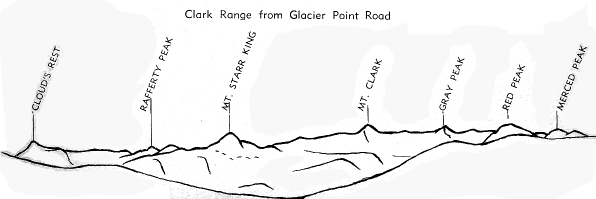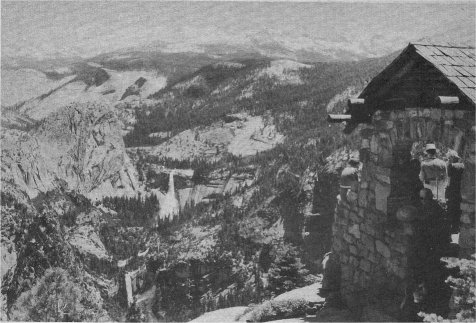
[click to enlarge]
Merced Canyon and foothills westward from Glacier Point Road
| Online Library: | Title | Author | California | Geology | History | Indians | Muir | Mountaineering | Nature | Management |
Yosemite > Library > Auto Tour > Chinquapin to Glacier Point (“G”) >
Next: Big Oak Flat Road (“C”) • Contents • Previous: Mariposa Grove (“B”)
(Total driving distance 18 miles)
G-0 GLACIER POINT ROAD. The original road to Glacier Point, built in 1882, was acquired by the Federal Government in 1917 along with the old Wawona Road, at which time tolls were abolished. The present road was completed in 1936 and follows the original road bed in many places.
(1.9 miles)
G-1 MERCED CANYON VIEW. Below is seen the gorge of the Merced River winding through the foothills with the Merced Road paralleling it. Near where these disappear beyond a bend are buildings of El Portal just outside the west boundary of Yosemite National Park. On a clear day you can see the San Joaquin Valley where the town of Merced is located and on the other side of the valley the Coast Range, about 125 miles distant. The Wawona Road passes directly beneath you at this viewpoint. In front of you is a sugar pine with its typical ungainly branching form.

[click to enlarge] Merced Canyon and foothills westward from Glacier Point Road |
(3.1 miles)
G-2 BADGER PASS. This is Yosemite’s principal skiing” area where as many as 3000 visitors ski on a busy Sunday. The ski runs are tailored for the entire family, small beginner’s slopes progressing to steeper terrain for the better skiers. The runs vary in length from one-half to two miles. There are two T-bar Constam lifts and one rope tow. Badger Pass has a cafeteria, sales room, and ski school. During summer Badger Pass is one of the park’s most beautiful wildflower gardens where such flowers as blue camas, brodiaea, leopard lily, western blue flag, columbine, larkspur, wild strawberry, various lupines, wild geranium, cow parsnips, Sierra shooting star, various pentstemons, mimulus, asters, daisies and the blackeyed susan provide an unusual display.
(1.6 miles)
G-3 MERCED PEAK. This is the peak you see as you look directly ahead, elevation 11,722 feet. It is so named because it is the culminating point of the Merced River whose headwaters originate on nearby mountains.
(0.3 of a mile)
G-4 PEREGOY MEADOW. The large meadow which extends on both sides of the road just before you reach Bridalveil Creek is Peregoy Meadow. The horse trail from Clark’s Station, which eventually became part of the original Wawona Road to Yosemite Valley, ran through this meadow and it was here that in 1869 the Mountain View House, one of the first hostelries in the park, was built. The Mountain View House flourished until 1871 when the old Wawona Road became a reality. The meadow was named for Mr. and Mrs. Charles Peregoy who operated the hotel.
(0.4 of a mile)
G-5 BRIDALVEIL CREEK. This creek forms the beautiful Bridalveil Waterfall. In the Bridalveil basin the creek winds through a series of delightful meadows which abound with wildflowers in mid-summer. The stream is stocked with eastern brook and rainbow trout. A public campground borders the creek for a mile or so on the right of the highway and is reached by a narrow road leading off to the right.
(0.6 of a mile)
G-6 HORSE RIDGE. To the right on the horizon is Horse Ridge, a point famous for winter ski trips. Horse Ridge, 9000 feet in elevation, is directly above Ostrander Lake on the shore of which is Ostrander Ski Hut. This hut is open approximately February 15 to April 15, and is reached either on skis or by weasel trips operating out of Badger Pass. Overnight reservations must be made in advance.
(1.9 miles)
G-7 CLARK RANGE VIEW. Directly across the canyon is the Clark Range. Mt. Clark, the peak at the right - center, is 11,506 feet in elevation and was named after Galen Clark, the first guardian of the Yosemite Grant. This peak normally retains some snow throughout the year. The prominent sugar-loaf shaped peak is Mt. Starr King, named fog a well-known Unitarian pastor whose writings in the 1860’s called attention to the wonders of Yosemite.
(2.4 miles)
G-8 POTHOLE MEADOW. Pothole Meadow on the left derives its name from large depressions in the form of circular pools about five feet in diameter. Deep under the ground are hollows in the solid rock which were formed during the Ice Age. The hollows fill with water and form the pools. Here is one of the few definite evidences that glaciers reached such elevation. In summer a beautiful display of wildflowers grows in this meadow. In season the shooting star, corn lily and the rarely-seen marsh marigold are prominent.
(0.2 of a mile
G-9 VIEW OF SENTINEL DOME. looking ahead and slightly to the left you will see Sentinel Dome. The tree on the very summit is the world-famous Jeffrey pine which grows out of solid rock. A side road leads to the point about 200 feet below the summit. From there you can reach the summit of the dome on foot.
(1.1 miles)
G-10 SWITCHBACKS. This road follows much of the original road of 1882. Surprisingly you drop down 600 feet to reach Glacier Point. The downhill bend of the lower part of tree trunks is the result of snow pressure on the hillside during winter when these trees were young.
(0.9 of a mile)
G-11 WASHBURN POINT. In the 1870’s and 1880’s the Washburn Brothers drove their visitors from their Hotel Wawona either to Glacier Point or to the turn-around at the present Washburn Point, thus accounting for the name. Even without the view of Yosemite Valley the sweeping scene of the high Sierra from this point is most impressive. Some visitors today believe that they are at Glacier Point and return without going any farther.

[click to enlarge] Clark Range from Glacier Point Road |
(0.7 of a mile)
G-12 GLACIER POINT. From Glacier Point, approximately 300 yards beyond the hotel, you can see one of the most inspiring views possible in the park. From here you may look at Yosemite Valley, 3214 feet below, Yosemite Falls, North Dome, Basket Dome, Tenaya Canyon, Half Dome, Liberty Cap, Nevada Fall (upper) and Vernal Fall, as well as many peaks of the high Sierra. These may be identified with the aid of the accompanying sketch. The sketch on the opposite page will locate features seen in Yosemite Valley below. About 750 miles of trails wander through this country within the park. (Further information in Clark’s Trail Guides, available at museums and gift shops.) A path swinging off towards Half Dome leads to an overlook station where the geologic story is shown. No glaciers can be seen from this point. There are more than 20 glaciers and remnants of glaciers in the park, but all are located on the shaded, far sides of the high peaks. Only snow fields are to be seen from here. The name Glacier Point comes from the fact that during the glacial period two trunk glaciers, one in Tenaya Canyon (left of Half Dome) and the other in Little Yosemite Valley (right of Half Dome) joined in one huge glacier rising some 700 feet above this point.
The small Mountain House with cafeteria beside the Glacier Point Hotel is the reconstructed original one-story Glacier Point Hotel built by C. E. Peregoy of Peregoy Meadows and Mountain View House, probably about 1872. During the first winter it was crushed flat by snow. James McCauley then gave Peregoy $600 for the wreck and constructed the present two-story Mountain House from its materials. It is the oldest structure still in use in the park The hotel was built in 1917 by the Desmond Company which, following receivership, emerged as the Yosemite National Park Company and in 1925 joined with the Curry Camping Company to become the Yosemite Park and Curry Co. of today. This company now operates the Glacier Point Hotel. During the summer naturalist-guided wall about Glacier Point start near the comfort station. A man-made spectacle which attracts considerable interest the FIREFALL. Produced nightly during the summer and on special occasions during the remainder of the year, consists of a cascading stream of burning embers from a fire built at the tip of Glacier Point. The fire burns about one-half a cord of bark taken from dead-and-down red fir trees. When a signal is given from below, an employee of the hotel pushes the embers slowly over the cliff, using a long-handled rake The coals drop almost 1000 feet to a ledge where they die out. The firefall is thought to have been originated by James McCauley in 1871 or 1872. After years of intermittent firefalls the practice was eventually abandoned for a time. In 1899 David A. Curry revived it as a regular feature of camp entertainment, and now it is admired by thousands who view it from many vantage points.
The Yosemite High Sierra from Glacier Point

[click to enlarge] |

[click to enlarge] |

[click to enlarge] Exhibit and overlook at Glacier Point; Yosemite’s high Sierra, Nevada and Vernal Falls |
Next: Big Oak Flat Road (“C”) • Contents • Previous: Mariposa Grove (“B”)
| Online Library: | Title | Author | California | Geology | History | Indians | Muir | Mountaineering | Nature | Management |
http://www.yosemite.ca.us/library/auto_tour/glacier_point.html